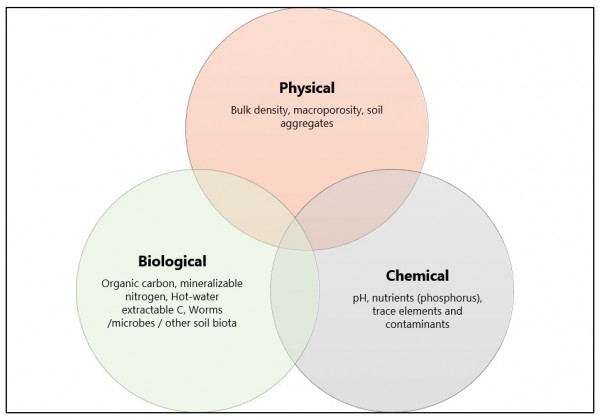In this section
In New Zealand, we typically measure a group of seven indicators as a minimum dataset: pH, total carbon, total nitrogen, Olsen P, mineralizable N, bulk density (Sparling and Schipper 2004). Trace elements such as cadmium are also generally measured. Other possible indicators are listed below. Biological indicators remain a major gap as there are few indicators that are widely accepted across a range of land uses.
Quantitative and qualitative indicators (and other examples) of physical, chemical and biological soil health indicators are summarised below and in Figure 1.

Figure 1. Examples of physical, chemical and biological soil health indicators
Quantitative indicators to measure soil health
Physical indicators include:
- soil bulk density
- macroporosity (which relate to compaction)
- soil aggregates which help to determine soil structure
Chemical indicators include:
- pH,
- nutrients/fertility
- trace elements and pollutants
Organic matter and biological indicators include:
- total organic carbon (C) and nitrogen (N),
- mineralizable nitrogen (as a surrogate for microbial biomass)
- measures of labile or soluble carbon and nitrogen (such as hot-water extractable C and N).
- abundance and diversity of microbes and other soil biota such as worms (difficult to measure, variable over time or difficult to interpret)
- soil food web interactions
- Pests and undesirable biota
Qualitative indicators of soil health
- Though laboratory methods are generally favoured for assessing soil health trends over time, other measures such as the Visual Soil Assessment (VSA) are also encouraged for landowners to become familiar with the state of their soils. VSA requires no laboratory analyses and can assess broad characteristics of the soil such as soil structure, drainage and earthworm activity.
VSA Resources available
For a free basic version of VSA see: https://www.landcareresearch.co.nz/publications/books/visual-soil-assessment-field-guide/download-field-guide
For more specific versions of VSA see: https://www.bioagrinomics.com/visual-soil-assessment
Reference
Sparling GP, Schipper LA 2004. Soil quality monitoring in New Zealand: trends and issues arising from a broad-scale survey. Agriculture Ecosystem & Environment 104: 545–552.